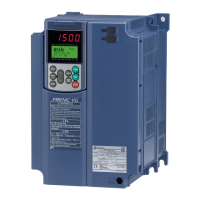5-57
where,
R1: Primary resistance of the motor (:)
Cable R1: Resistance of the output cable (:)
V: Rated voltage of the motor (V)
I: Rated current of the motor (A)
%X (P08): Enter the value calculated by the following expression.
(%)=%X 100×
)I×3(/V
XCable+XM)+(X2/XM×X2+X1
where,
X1: Primary leakage reactance of the motor (:)
X2: Secondary leakage reactance of the motor (converted to primary) (:)
XM: Exciting reactance of the motor (:)
Cable X: Reactance of the output cable (:)
V: Rated voltage of the motor (V)
I: Rated current of the motor (A)
Rated slip frequency (P12)
Convert the value obtained from the motor manufacturer to Hz using the following expression
and enter the converted value. (Note: The motor rating given on the nameplate sometimes
shows a larger value.)
(Synchronous speed - Rated speed)
Rated slip frequency (Hz) =
Synchronous speed
x Base frequency
For reactance, choose the value at the base frequency 1 (F04).
P09
P10
P11
Motor 1 (Slip compensation gain for driving)
(Slip compensation response time)
(Slip compensation gain for braking)
P09 and P11 determine the slip compensation amount in % for driving and braking individually.
Specification of 100% fully compensates for the rated slip of the motor. Excessive
compensation (P09, P11 ! 100%) may cause a system oscillation, so carefully check the
operation on the actual machine.
P10 determines the response time for slip compensation. Basically, there is no need to modify
the default setting. If you need to modify it, consult your Fuji Electric representatives.
P99 Motor 1 Selection
P99 specifies the motor to be used.
Data for P99 Motor type
0 Motor characteristics 0 (Fuji standard motors, 8-series)
1 Motor characteristics 1 (HP rating motors)
3 Motor characteristics 3 (Fuji standard motors, 6-series)
4 Other motors
Automatic control (such as auto torque boost and auto energy saving) or electronic thermal
overload protection for motor uses the motor parameters and characteristics. To match the
property of a control system with that of the motor, select characteristics of the motor and set
H03 data (Data Initialization) to "2" to initialize the old motor parameters stored in the inverter.
When initialization is complete, P03, P06, P07, and P08 data and the old related internal data
are automatically updated.

